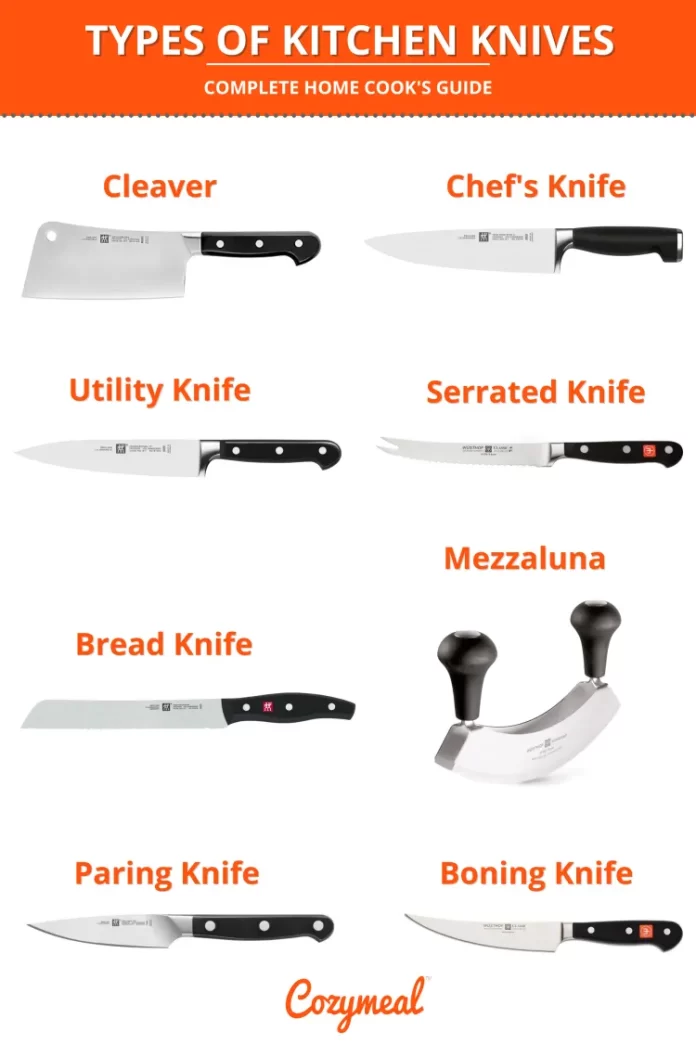Do you love cooking? Maybe yes, maybe no? However, some people love the idea of cooking, chopping, and preparing meals for their families. For those who love to cook food or those who have the responsibility of making food, we have a guide. You might not think about knives a lot, but there are various types of knives.
All types of kitchen knives have their own purpose, depending on the task at hand. Including them in your kitchen tools will make the process more fun and even more accessible. In addition, to enjoy cutting and chopping meat or vegetables, the food will be more delicious. The way you cut the food also determines the taste of your meal. If you have not noticed it yet, you will now.
Types of Knives
Serrated Knife: This knife cuts tomatoes, bread, and meat. These knives are appropriate for foods with two different textures – on the inside and outside. For example, think about the tomato, it has a slightly tighter skin on the outside, but it is soft and juicy from the inside. Thus, a serrated knife is suitable for such foods.
Carving/Slicing Knife: You can find this knife easily. It has a long blade and a straight edge. The edge is slightly rounded at the tip (occasionally with shallow scallops, mostly on sides termed Granton). It is thinner compared to a chef’s knife. You can use it to carve meat and poultry. The knife’s structure helps make thinner slices and gives you beautifully sliced meat.
Utility Knife: Smaller fruits and vegetables, such as shallots, are best chopped using a utility blade. This is because it has many of the same characteristics as a chef’s knife. However, it is more advantageous when dealing with small food items since the utility knife enables more accurate cutting operations. Therefore, opt for a utility knife if the cook’s knife is overly large for the job.
Paring Knife: You can use this knife to perform small tasks like tomatoes, potatoes, and strawberries. Also, chopping shallots and garlic, cutting ribs off peppers, deveining shrimp, and cutting dates and cherries are all lighter and more agile activities. Since a paring blade is frequently used in the atmosphere instead of on a chopping board, it should have a thin plastic grip and a somewhat flexible edge. A paring knife should be 3 – 3-1/4 inches in length; something shorter will not cut through all of the items you may need it for, but anything longer will be challenging to manage.
Bread Knife: The bread knife’s significant edge and keen serrated blade are perfect for cutting through various pieces of bread, especially crusty bread, croissants, bagels, or bread rolls. This happens due to the serrated edge, which helps the cook to cut past softer materials without smashing them. A bread knife can also be employed to slice light, fluffy cakes since they cut into them without forcing the air away from the sponge or altering the overall form. Finally, if you lack a cake leveler, the bread knife may be used to smooth out homemade sponge cakes after they have been baked.
Chef Knife: The chef’s knife is perhaps the most utilized, so it is worthwhile to purchase an excellent one and take care of it. These knives can cut, slice, and julienne almost anything, carve a steak or disintegrate a watermelon. It must be a robust yet compact knife with a long blade and a comfortable handle. You would like a knife that functions in your favor and that you remain comfortable with on those hectic cooking days.
Damascus knives were created using an old technology that had long since been lost. However, Perkin Knives has discovered a means to produce robust, durable, and trustworthy Damascus knives that aid in simple slicing, chopping, and cutting. A Damascus steel kitchen knife is the best you will find.



















